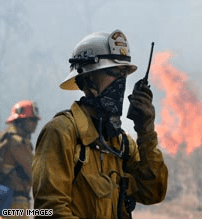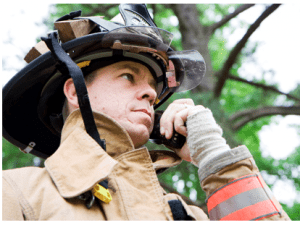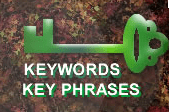 A frequent contributing factor in firefighter casualty incidents is too much radio traffic. This can have a significant impact on first responder situational awareness because it becomes near impossible to take in, process, comprehend and remember the volumes of information being transmitted over the radio when communication is not disciplined. This article explores some of the causes of the problem and makes some recommendations for improving radio discipline.
A frequent contributing factor in firefighter casualty incidents is too much radio traffic. This can have a significant impact on first responder situational awareness because it becomes near impossible to take in, process, comprehend and remember the volumes of information being transmitted over the radio when communication is not disciplined. This article explores some of the causes of the problem and makes some recommendations for improving radio discipline.
Have radio, must talk
 On numerous occasions I have had conversations with fire chiefs who said they regretted issuing a radio to every member. They said the concept was good – give everyone a radio in case they get into trouble they can call for assistance. However, the strategy backfires when everyone who has a radio feels compelled to talk on it. It’s tantamount to a person thinking that because they are carrying an axe, they must chop something. A radio is a tool to be used for a specifically intended purpose. Unfortunately, most fire departments do not train firefighters on how and when to use a radio.
On numerous occasions I have had conversations with fire chiefs who said they regretted issuing a radio to every member. They said the concept was good – give everyone a radio in case they get into trouble they can call for assistance. However, the strategy backfires when everyone who has a radio feels compelled to talk on it. It’s tantamount to a person thinking that because they are carrying an axe, they must chop something. A radio is a tool to be used for a specifically intended purpose. Unfortunately, most fire departments do not train firefighters on how and when to use a radio.
Radio training
 It should not be assumed that a firefighter will automatically know how and when to talk on a radio. To assume so is to make a great leap of faith that will, undoubtedly, come back to bite the assumer in the behind. Talking on a radio is not an intuitive task. Knowing what to say, how to say it and when to say it are skills that must be taught.
It should not be assumed that a firefighter will automatically know how and when to talk on a radio. To assume so is to make a great leap of faith that will, undoubtedly, come back to bite the assumer in the behind. Talking on a radio is not an intuitive task. Knowing what to say, how to say it and when to say it are skills that must be taught.
Having listened to numerous audio recordings of incidents where firefighters were injured or killed, it is painfully evident that this still has not been taught and, if it has been, the instructions were poor or the radio user has fallen out of practice with best practices.
Best practices
 Radio transmissions can provide critical clues and cues that, when transmitted properly and timely can be a tremendous asset in the development and maintenance of situational awareness. Those demonstrating the best practices in radio usage know what to say, how to say it, who to say it to, and when to say it. And, perhaps of equal importance, they know what NOT to say, how NOT to say it, who NOT to say it to and when to stay off the air.
Radio transmissions can provide critical clues and cues that, when transmitted properly and timely can be a tremendous asset in the development and maintenance of situational awareness. Those demonstrating the best practices in radio usage know what to say, how to say it, who to say it to, and when to say it. And, perhaps of equal importance, they know what NOT to say, how NOT to say it, who NOT to say it to and when to stay off the air.
Prioritizing radio messages
 I recently had a discussion with some firefighters about their radio discipline. After deciding their incident management is hampered from too much radio traffic, they have embarked on a mission to revamp how they use their radios. They have decided:
I recently had a discussion with some firefighters about their radio discipline. After deciding their incident management is hampered from too much radio traffic, they have embarked on a mission to revamp how they use their radios. They have decided:
Radio transmissions fall into one of three categories: Urgent, Necessary, and Unnecessary. [tweet this]
For Urgent messages, the transmission will start with the word “Urgent” followed by the message. The department is developing a list of examples of urgent messages and training personnel on why those messages would be considered urgent.
Necessary radio traffic will not have a pre-empted word and the department will provide members with a definition of necessary radio traffic and some examples.
Unnecessary radio traffic will be defined and a sample list will be provided to the members. Unnecessary radio traffic will no longer be transmitted over the radio. Instead, it will be stated face-to-face, by mobile data computer, or will not be communicated at all.
Cadence and key phrases
 The department is also going to adopt a cadence protocol. Cadence is when the same thing is said on the radio in the same order (or sequence) every time. For example, when giving a progress or update report the crew employs the acronym C.A.N. (Conditions, Actions, Needs). Or, when calling a mayday, the department would give a L.U.N.A.R. report (Location in the building, Unit designation, Names of personnel needing assistance, Air supply remaining, and Resource needs).
The department is also going to adopt a cadence protocol. Cadence is when the same thing is said on the radio in the same order (or sequence) every time. For example, when giving a progress or update report the crew employs the acronym C.A.N. (Conditions, Actions, Needs). Or, when calling a mayday, the department would give a L.U.N.A.R. report (Location in the building, Unit designation, Names of personnel needing assistance, Air supply remaining, and Resource needs).
The department is also going to adopt key phrases that will be used to communicate a broader concept. Personnel will be trained on what the key phrases mean so when communicated, the meaning is shared among the sender and the receiver(s).
Audits
 The fire department is going to conduct audits of recorded radio transmissions to ensure the new procedure is being followed. As with anything new, this procedure entails a paradigm shift for how the department uses radios. They should expect to show steady progress toward changing habits. It is important for the audits to be conducted on both significant alarms and non-significant alarms. The habits developed during the many non-significant alarms will become the automatic performance during significant alarms. Ensuring the new procedures are being used consistently across the board is important.
The fire department is going to conduct audits of recorded radio transmissions to ensure the new procedure is being followed. As with anything new, this procedure entails a paradigm shift for how the department uses radios. They should expect to show steady progress toward changing habits. It is important for the audits to be conducted on both significant alarms and non-significant alarms. The habits developed during the many non-significant alarms will become the automatic performance during significant alarms. Ensuring the new procedures are being used consistently across the board is important.
Chief Gasaway’s Advice
 Radio communication is critical to the success of an incident and is vital to developing and maintaining situational awareness. [tweet this] Disciplined communication reduces the possibility of radio channel overload and it reduces the possibility of cognitive overload by those who are listening to the radio.
Radio communication is critical to the success of an incident and is vital to developing and maintaining situational awareness. [tweet this] Disciplined communication reduces the possibility of radio channel overload and it reduces the possibility of cognitive overload by those who are listening to the radio.
Reducing the amount of unnecessary radio traffic will also reduce the possibility that personnel operating at the scene (including the commander) will not “tune out” the radio because of the volume of chatter that is impacting the ability to comprehend other things. The brain only has a limited capacity to process information and under stress it’s not that hard to overload the brain. Reducing radio traffic to urgent and necessary messages only is a best practice that will improve responder safety.
Discussion Questions
 1. Develop a definition and create a list of urgent, necessary and unnecessary radio transmission.
1. Develop a definition and create a list of urgent, necessary and unnecessary radio transmission.
2. Obtain an audio tape from one of your department’s recent significant events. Categorize the radio transmissions as urgent, necessary and unnecessary. Record the percentage of airtime from the incident dedicated to each.
3. Discuss strategies for how to eliminate unnecessary radio transmissions.
The mission of Situational Awareness Matters is simple: Help first responders see the bad things coming… in time to change the outcome.
Safety begins with SA!
_________________________________________________________________________________
Share your comments on this article in the “Leave a Reply” box below. If you want to send me incident pictures, videos or have an idea you’d like me to research and write about, contact me. I really enjoy getting feedback and supportive messages from fellow first responders. It gives me the energy to work harder for you.
Thanks,
Email: Support@RichGasaway.com
Phone: 612-548-4424
Facebook: www.facebook.com/RichGasaway
Facebook Fan Page: www.facebook.com/SAMatters
LinkedIn: Rich Gasaway
Twitter: @RichGasaway
YouTube: SAMattersTV
iTunes: SAMatters


If you want to hear good radio discipline, you can “tune in” on line to many air traffic control frequencies. Atlanta Approach in the late afternoon (when thunderstorms are popping up) can be a real education. So much is communicated with so few words…because everyone knows the discipline, sequence, shorthand and system. Even voice inflection and other non-verbals play a part in making it all work.
Dr. Kiefer,
Excellent recommendation. When I was doing my research I had the opportunity to spend some time in the control tower of a busy international airport. Wow, was I impressed with their management of heavy radio traffic. It was also very obvious to me that what I was hearing was very difficult for me to understand because I didn’t know the terminology and the cadence. Once someone taught me what things meant, I did much better tracking what was being communicated.
Thanks for contributing. Your experience in the fire service and as an aviator is valuable to this discussion.
Rich
Rich,
Excellent article. I have found myself getting frustrated during incidents because of too much radio traffic and often doing a face to face to be sure my message gets through- of course that doesn’t necessarily help the interior crews when too much radio traffic is occuring.
Bob,
Thanks for sharing your experience with the readers and thank you for your kind words. Ironically, frustration is a barrier to situational awareness because that causes our attention to be drawn to what frustrates us. Thus, too much radio communications (a barrier to SA) coupled with frustration (another barrier to SA) causes a double whammy problem.
Rich
Excellent article. I cannot imagine anything more frustrating that trying to communicate in a busy channel to ask for help or any other critical issue.
In my experience as ambulance dispatcher it is necessary to limit the amount of users per channel in order to constrain the occupation and saturation of that channel. The longer the messages, the less amount of users.
Also, autonomy is key element. A higher degree of autonomy will allow fewer and shorter communications. I recommend reading the book COMMAND CONCEPTS.
https://www.rand.org/content/dam/rand/pubs/monograph_reports/2006/MR775.pdf
Juan